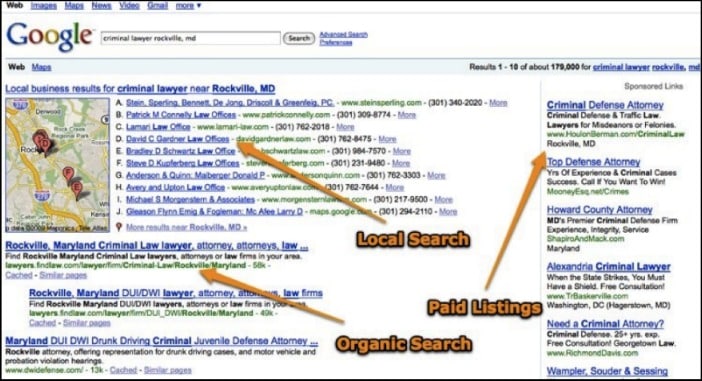Unless you’ve been living under a rock lately, you have probably heard that Google has now revised their desktop user interface to eliminate ads from showing on the right sidebar. This is a huge change that affects many people, and it’s important to understand why Google made this adjustment, and what it means for you.
On late February of 2016, Google rolled out a revised desktop user interface without right-hand ads.
What Has Changed
Although Google’s user interface has appeared to remain the same over the years, there have actually been many changes that have been implemented. For example, back in 2007, Google did not always show any top ads, and if they did, it was usually only one or two organic results.

Screenshot circa 2007
Today, Google’s search pages show four ads at the top, as well the beginning of a map section. Additionally, some of the ads now have six lines, as opposed to the previous maximum of three lines.

Screenshot 3.2016
Cost Per Click Prices will Increase
Since there are fewer available ad spots on the search result page, Cost Per Click prices will increase. In other words, advertisers will have to up their bids in order to get above the fold impressions. However, some say that with the additional fourth spot and ads still remaining at the bottom of the page, the change isn’t so drastic. But there is still a lesson to be learned about mobile bidding, and it’s that you need to be at the top positions to get those clicks. There will be significantly more competition for the top spots, which increases Cost Per Click prices. When this increases, the value of organic ranking will also increase because Adwords is all about the value of keyword.
Organic Click Through Rates will Decrease
With the new changes, users now have to scroll down the search page to find the organic results. If we look back at the comparison of 2007, you’ll see that today, Google has increased the size of the map and local results. While the local search results were decreased from showing seven to only showing three, the amount of screen shown was increased to actually such results. As a result, organic results were again, pushed further down the page. Now, with the fourth ad spot being available for highly commercial search queries, the organic results are being pushed even further down the page, which is why those top positions in Google are so favorable. However, results that appear lower on the page tend to have a lower click through rate, and this is expected to decrease even more.
Third party CTR data shows a rapid drop in the CTR as position increases. This winner takes all phenomena has been discussed extensively and is why top positions in Google are so valuable.

Source: Advancedwebranking.com/ctrstudy
Value of Organic Rankings
You may be wondering how a decreased click through rate and increased cost per click will affect SEO. This can easily be determined by using a formula that calculates the value or organic rankings.
Monthly Organic Value = Monthly Volume x CTR of Position x Adwords CPC
This exact formula takes the cost of running Adwords campaigns as an equivalent for the organic results. The keyword planner provides approximate cost per clicks, as well as the monthly number of search for said keyword. Then, the estimated click-through rate is then provided for that keyword. Thus, an estimate in the value of organic rankings is provided.
What this essentially means is that there would be no reason for advertisers to pay a flat fee for organic listing, as opposed to paying for Adwords. However, paying Google for an organic slot isn’t even an option, but you get the jest of it.
SEO is Still Here
Now, it is unfair to say that these are the exact changes that will be seen for CTR and CPC. However, the prediction is that Cost per Click will increase more than the actual organic Click Through Rate decreases. If this is accurate, it means that the value of an organic position will also increase. Thus, companies will be more willing to spend even more money on programs that improve their rankings. This can also be said for local SEO, as more small businesses will be eager to appear in the local 3-pack of Google.
So, what does this all mean? Google’s user interface is still quite far from becoming a page strictly of paid-for-ads, and SEO still has a significant amount of power and value to businesses. Things will certainly be more competitive, especially for those ad positions, but with a strong SEO strategy, you can still prevail within the search results.
Conclusions
While we are still a long way from a Google UI that is all ads, the most recent change by Google notches us one step closer. For people questioning the value of SEO, these most recent changes will only make the organic results more value to businesses. Here is what we see happening:
- Adwords CPC will increase especially for competitive niches. Advertisers will be forced to ante up or get out of the auctions.
- Organic CTR will decrease due to the new fourth ad on highly commercial search queries.
- The estimated value of an organic ranking will increase because Adwords CPC will increase at a higher rate than the decrease in organic CTR.
- Everything gets more competitive leading more businesses dabbling in SEO or PPC to make real investments or get out.
- Map pack rankings are the low hanging fruit for small businesses but Google has already amped up the competition with their 7 to 3 Pack.
- SEO is NOT dead!

